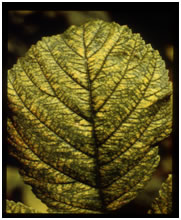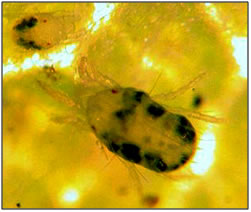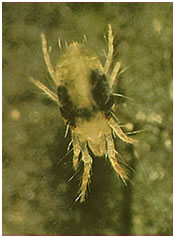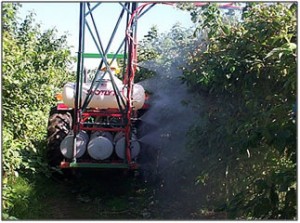Washington State University
Mount Vernon Northwestern Research and Extension Center
Mount Vernon, WA 98273-4768
360-848-6152
Yellow spider mite field trial.
Population levels of spider mites in northwestern Washington exceeded expectations given the unseasonably cool, wet spring and early mild summer temperatures. This in contrast to 2007 when spider mite populations were generally non-economic ones, especially in northwestern Washington. Problematic flare-ups of the yellow spider mite (YSM),Eotetranychus carpini borealis, were particularly severe in the Northwood area of Lynden where late May population on both ‘Meeker’ and ‘Willamette’exceed our provisional treatment level of 25 motile life stages per leaf by 10 to 100-fold. Female YSM emerge from diapause earlier and disperses earlier than the twospotted spider mite (TSSM) from mid-April to May. This species migrates to distal primocane foliage along the top trellis wire of red raspberry in April to May. Our research data has shown the YSM prefers cooler spring and fall temperature. The onset of warm weather combined with stressed foliage provided the right conditions for a mid-season (May to August), region wide flare up of mostly YSM and lesser levels of the TSSM and European red mite on the distal half of the canopy bearing most of the developing flower buds.
On 8 July 2008, we field-tested two rates of the recently registered Acramite 50WS (bifenazate) and Acramite 4SC and experimental Envidor 2SC (spirodiclofen) with Vendex™ (fenbutatin-oxide) on a mature ‘Meeker’ site in Lynden, WA. Envidor is a Group 23 acaricide. Applications were applied with our plot spray equipped to deliver 133 gpa at 1.8 mph with 2 D4-45 Tee Jet nozzles on top of boom, with 2 D2-25 nozzles pointing up into the row while both vertical arms were equipped with 14 D3-25 Tee Jet nozzles. Treatments were replicated five times and plots measure 30 feet long by 10 feet wide. Twenty-five leaflets were taken at random from primocanes at chest height from both sides of the row. These samples were processed with a mite brushing machine. Compared with the untreated check, empirically all miticides performed comparably to each other and all were significantly different from the untreated check out to 37 DAT (Table 1).



| Treatment | lb(AI)/acre | Motile TSSM/leaflet | ||||||||
|---|---|---|---|---|---|---|---|---|---|---|
| Ptrm | 3DAT | 6DAT | 10DAT | 14DAT | 23DAT | 30DAT | 37DAT | 44DAT | ||
| Means within columns followed by the same letter are not significantly different (Fisher’s protected LSD, P<0.05), PRC ANOVA SAS. | ||||||||||
| Acramite 50WS | 0.37 | 8.2a | 0.2b | 0.2b | 0 | 0.1b | 0 | 0.1b | 0 | 0 |
| Acramite 50WS | 0.50 | 12.5a | 0.6b | 0.4b | 0 | 0.4b | 0 | 0.1b | 0 | 0 |
| Acramite 4SC | 0.50 | 10.5a | 0.7b | 0.2b | 0 | 0.1b | 0 | 0 | 0 | 0 |
| Envidor 2SC | 0.28 | 9.5a | 0.6b | 0.2b | 0.1b | 0.2b | 0 | 0 | 0 | 0 |
| Vendex 50WP | 1.00 | 9.8a | 0.4b | 0.4b | 0.0 | 0.2b | 0 | 0 | 0 | 0 |
| Untreated check | 10.6a | 8.6a | 5.8a | 1.8a | 3.5a | 1.3a | 1.0a | 0.7a | 0.4b | |
Mixed spider mite field trial.
A postharvest population of twospotted spider mite, Tetranychus urticae and yellow spider mite were sampled and treated on 25 September 2008 in a three year-old ‘Meeker’ field at the WSU Mt. Vernon NWREC. Pretreatment densities for these late season infestations approximated 10-13 motile life stages/leaf. Though non-economic, these numerically increasing populations and cool/cloudy weather conditions were ideal to compare formulations of Acramite 50WP and Acramite 4SC with experimental IGR Envidor 2SC on an established twospotted spider mite and incipient yellow spider mite infestation. Rates and application methods were identical to those used for YSM above. A silicone surfactant (0.5% v/v) and Volck supreme oil (1% v/v) was included with Acramite and Envidor, respectively. The method and applications were applied as reported above for the Lynden red raspberry trials. Compared with the untreated check, Acramite 50WP provided six-fold reduction suppression of motile spider mites at 13 days posttreatment (Table 2). This compared with an average comparable to the untreated check at 13 DAT. This result was significantly different from these treatments at the Lynden site in mid-summer for YSM.


| Treatment | lb(AI)/acre | Motile YSM/leaflet | |||
|---|---|---|---|---|---|
| Ptrm | 4DAT | 7DAT | 13DAT | ||
| Means within columns followed by the same letter are not significantly different (Fisher’s protected LSD, P<0.05), PRC ANOVA SAS. | |||||
| Acramite 50WS | 0.50 | 10.4a | 0.9b | 6.3a | 4.6b |
| Acramite 4SC | 0.50 | 12.8a | 3.3b | 9.5a | 23.5a |
| Envidor 2SC | 0.28 | 13.2a | 3.1b | 7.0a | 14.3ab |
| Untreated check | 11.9a | 9.5a | 14.3a | 27.7a | |